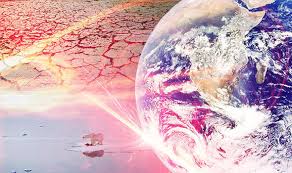What is a hothouse state? « Back to Questions List
|
Hothouse state is climate state beyond which human attempts to reduce emissions will be practically unsuccessful. This state could be reached in Earth because of cascading effects of warming seas, perishing forests, melting glaciers and shifting currents. Once the Earth crosses a threshold temperature, these actions might lead to a hot house state resulting in additional temperature rise through self-reinforcing feedbacks. The hothouse climate state is assumed to have happened on Venus. Results of a study published on August 6, 2018 indicate that the world is nearing the state of hothouse conditions. The researchers state that global temperatures might stabilize with 4-5 degrees Celsius higher above the pre-industrial area even if the emission reduction targets aimed under Paris Climate deal are achieved. At this stage, due to melting of ice, the sea level could be higher by 10-60 meters than at present. These effects will make some parts of the Earth uninhabitable. According to the study, the temperature threshold could be below the 2 degree Celsius temperature target agreed as the Paris Climate accord. They states that temperature threshold could reach once the Earth warms to 2 degree Celsius over pre-industrial era and the planet has already warmed 1 degree Celsius and is warming at a rate of 0.17 degree Celsius per decade. The observations were published in Proceedings of the National Academy of Sciences. They study was conducted by Rockström and his co-authors. They are considered as the world’s leading authorities on positive feedback loops. In a positive feedback loop, increased temperature causes new greenhouse gases to be released or poil the Earths ability to absorb carbon or reflect heat. The study analyzed combined after effects of ten climate change processes. These included release of methane trapped in Siberian permafrost and the consequences of melting ice in Greenland on the Antarctic. Soil, rock or sediment that remains frozen for more than two consecutive years is termed permafrost. According to scientists, once the threshold temperature is breached, several tripping points will undergo rapid and abrupt changes. These changes include permafrost thaw, release of methane hydrates from ocean floor, weaker land and ocean carbon sinks, loss of Arctic summer sea ice and the reduction of Antartic sea ice and polar ice sheets. Thus the hothouse trajectory will lead to flood, storms and cyclones, and elimination of coral reefs by the end of this century or even earlier. The study is a warning. There is also a solace in the statement by authors themselves that the study is not conclusive. But the scientists world over are not ready to discard the observations in the era of global warming and climate change. This is because the report has come amid a heat wave that pushed temperature above 40 degree Celsius in Europe leading to wildfires. The major cause for the blazes in Greece in July, 2018 that killed 91 people was this heat wave. Global DimmingClimate Change, Global Warming and Lima Conference,2014 |

